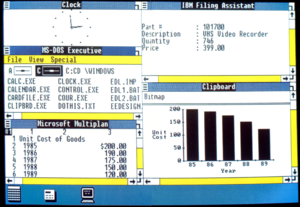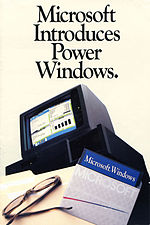Windows 1.0
| Microsoft Windows操作系统的一个版本 | |
 Windows 1.0的截图 | |
| 开发者 | 微软 |
|---|---|
| 操作系统家族 | Microsoft Windows |
| 原始码模式 | 不开放源代码 |
| 首次发布 | 1985年11月20日 |
| 当前版本 | 1.04 (1987年4月) |
| 内核类别 | MS-DOS |
| 许可证 | 专有商业软件 |
| 后一代 | Windows 2.0(1987年) |
| 支持状态 | |
| 2001年12月31日后停止支持 | |
Windows 1.0是Microsoft Windows的首个主要版本,但其本身并不是操作系统,而是基于MS-DOS内核的图形应用程式环境。它于1985年11月20日在美国首次发布,而欧洲版本于1986年5月以Windows 1.02的形式发布。
Windows 1.0的开发始于1982年的电脑经销商博览会,微软的联合创始人比尔·盖茨看到了类似软件Visi On的演示。1983年11月,Windows 1.0首次公开亮相,并得到了一些硬件和软件制造商的支持。但其推迟到两年后才发行。Windows 1.0以16位外壳程序的形式在实模式下运行。该环境中能够运行为Windows设计的图形程序以及先前的MS-DOS软件,各个程序窗口只能平铺排列而不能堆叠排列;同时引入了多任务处理,并支持滑鼠,还包括一些内建程序,如计算器、画图、记事本。Windows 1.0共发布了四个版本,后续版本中主要添加了对新硬件及其他语言的支持。
Windows 1.0反响平平:批评主要聚焦于其软件兼容性和性能问题,而现代的科技媒体普遍认可它在Windows历史上的地位。它的最后一个版本是1.04,随后被1987年12月发布的Windows 2.0所取代。Windows 1.0于2001年12月31日终止支持,是支持时间最长的Windows版本。
开发
[编辑]
20世纪80年代左右,电脑正从字符用户界面过渡到图形用户界面。[1]1981年,微软产生了开发基于位图的图形用户界面的想法。[2]1982年的电脑经销商博览会上,微软的联合创始人比尔·盖茨看到了Visi On的演示,这是由VisiCorp开发的一套用于IBM PC兼容机的图形用户界面软件包。这启发微软开发自己的图形界面。[3][4]受限于当时的电脑配置,微软将这套图形界面定位为具有启动器功能的扩展模块,并着手开始开发。[1]1983年初,苹果电脑公司发布了Apple Lisa。这款产品的图形用户界面同样基于位图,并借鉴了施乐公司的研究成果,取得了长足进展;[2][5]不过其售价高昂,很多用户望而却步。微软希望开发出更便宜的产品,同时也需要有独特之处。[2][6]同年8月,比尔·盖茨招募了斯科特·A·麦格雷戈作为新图形界面的开发团队负责人,他是施乐之星中视窗系统的关键开发人员之一。[7]:253–255[8]:157[9]在视窗系统开发前,这套图形界面被简单地称为“界面管理器”(Interface Manager)。[10][11][注 1]麦格雷戈将自己先前开发的视窗系统称为“Windows”,同时微软营销副总裁罗兰·汉森也提议使用“Windows”这一名称:该词在软件中频繁出现;同时该词在英语中很常用,因此当媒体提及该产品时,必须在前加上公司名称“Microsoft”以避免混淆,这样能够提高微软的知名度。比尔·盖茨接受了这个意见,将该产品命名为Windows。[7]:242–245[12][13]
1983年9月,微软首次向媒体展示了Windows原型,其用户界面类似于Multiplan以及其他当时的微软应用,屏幕底端有命令栏;同时还能够同时显示多个应用程式窗口,既可以堆叠排列,也可以平铺排列。[14]这个用户界面概念很快被重新设计,只支持平铺窗口,并将类似Multiplan的命令栏更改为标题栏下的菜单栏。[15]许多观点认为,微软做出这一决定是为了避免与Classic Mac OS雷同。[12][16]不过根据微软工作人员坦迪·特罗尔的说法,这可能只是早期项目经理的偏好。[16][17]重新设计后的环境在1983年11月的秋季电脑经销商博览会上首次公开亮相。[15]最初,微软将这款软件称为MS-DOS 2.0的设备驱动程式,需要192KB的内存和两个软盘驱动器。当运行“行为良好”(仅使用MS-DOS的系统调用)的程序时,Windows能够同时处理多个平铺窗口的任务;当运行“行为不良”(不使用MS-DOS的系统调用,而是直接操作硬件地址以控制硬件)的程序时,Windows会让其全屏运行。通过这种方式,Windows能够运行MS-DOS中的应用程式。这让Windows从Visi On和Apple Lisa中脱颖而出。同时,与Visi On不同,Windows开发人员不需要使用Unix开发IBM PC应用程式。微软计划在第三方应用程式中不再强制要求使用微软的用户界面,以鼓励包括竞争对手在内的其他公司开发Windows程序。[14]
一些MS-DOS电脑制造商(包括康柏、增你智、迪吉多)和软件公司(包括阿什顿-泰特、莲花)承诺提供对Windows的支持。[15]1983年12月,BYTE杂志在预览Windows后,称其“似乎提供了非凡的开放性、可重新配置性、可移植性,以及合适的硬件要求和定价……除非其他公司推出让人惊喜的产品,否则Windows将优先在大范围内测试桌面比拟这一概念。”[14]Windows刚诞生时,比尔·盖茨就将其视为微软的未来。他在1984年4月告诉InfoWorld杂志:“我们公司的战略和资源完全倾向于Windows,就像我们专注于MS-DOS和Xenix之类的操作系统内核一样。我们也强调,只有充分利用Windows的应用程式才能长期保持竞争力。”[18]但IBM并未出现在支持硬件制造商的名单中。[15]IBM最初拒绝在其销售的设备上预装Windows,转而开发自己的产品TopView。[17]微软称Windows与TopView不同,强调其目的不是多任务处理,而是“让电脑成为内存占用较少且图形丰富的环境”。[19]到了1984年末,Windows、TopView、数字研究公司的Graphics Environment Manager这三款视窗系统间存在竞争,有媒体称之为“视窗之战”(War of the Windows)。[19]麦格雷戈于1985年1月离开团队后,史蒂夫·鲍尔默接替了他的位置。[17]后来,微软说服IBM需要图形用户界面,[2]两家公司联合开发OS/2,并于1987年12月完成了初代版本,旨在取代MS-DOS和Windows。[20][21]
微软曾在1983年11月承诺于1984年4月前发布Windows,[15]然而,由于各种设计修改,其发布日期推迟,[22]并因此被称为“Vaporware”。[12]
版本发布
[编辑]- 1985年11月20日,微软发布了首个零售版本Windows 1.01,面向美国市场销售,售价为99美元(2023年约合280美元[23])。[16][24]
- 1986年5月,微软发布了Windows 1.02,主要针对欧洲市场,该版本增加了对其他语言的支持。[22][25]
- 1986年8月,微软发布了Windows 1.03,其包含了一些增强功能,包括支持非美国键盘[26]、添加一些显示器和打印机的驱动程式,从而取代了美国的1.01版本和欧洲的1.02版本,使得国际版本保持一致。[27]:README.txt同时,微软也与日本电气联合制作了日语版,并于1986年11月发售。[1]
- 1987年4月,微软发布了Windows 1.04,其增加了对IBM PS/2的支持。[22][28]
1987年12月9日,Windows 2.0发行。[29]:161Windows 1.0于2001年12月31日终止支持,[30]是迄今为止得到支持时间最长的Windows版本。[31]
功能
[编辑]Windows 1.0本身并不是操作系统,而是图形应用程式环境。[16]其基于MS-DOS内核,[32]:5[33]以16位外壳程序的形式在实模式下运行。[34][35]Windows 1.0允许多个程序同时运行,是多任务处理的早期想法。[16][36]:220各个程序窗口只能平铺在屏幕上,不能堆叠或重叠。程序中的内容会会自动调整大小以适应可用空间。[16]程序最小化后,其图标会出现在屏幕底部的水平线上,类似于现代的Windows任务栏。[12][22]该操作环境支持滑鼠,用户能够使用滑鼠在屏幕上单击。[37]与现代Windows操作系统不同,Windows 1.0中必须按住滑鼠按钮才能显示所选菜单。[22]
Windows 1.0包含简单的程序启动器和文件管理器——MS-DOS Executive,在其中打开.exe可执行文件将启动应用程式窗口。[16]Windows 1.0也附带了计算器、画图、记事本、书写器、终端、时钟、卡片档案等程序。[24][38]:17系统中还包含RAMDrive(用于管理存储卡,突破内存限制)、剪贴簿、打印后台处理程序等实用程序。[24]Windows 1.0内建了《黑白棋》这一依赖于滑鼠控制的电子游戏,旨在让用户学习如何移动滑鼠以及单击屏幕元素;[39]同时,《权力平衡》可能是唯一一款在Windows 1.0上发行的商业游戏。[16]Windows 1.0引入了控制面板,能够配置环境功能。[11]由于Windows的向下兼容性,现代Windows上很有可能能够直接执行Windows 1.0的二进制程序,并且仅需做很少修改即可将源代码重新编译为功能相同的“现代”应用程式。[40]
Windows 1.0还包含三个动态链接库,分别为KERNEL.EXE、USER.EXE、GDI.EXE。[41]其中KERNEL.EXE包含了诸如任务处理、内存管理、文件输入和输出等功能,USER.EXE提供了用户界面接口,GDI.EXE提供了图形设备接口。[42]:87[43]:66Windows 1.0 SDK中包含了这些文件的调试版本,可以用来替换安装盘上的相应文件。[44]:13,200安装程序合并了多个系统文件,以便加快启动速度。使用Windows 1.0 SDK提供的调试版本KERNEL.EXE,可以创建Windows 1.0的“慢启动”版本,其系统文件未经合并。[45]:README.TXTWindows 1.0可以移动内存中的程序代码和数据段,以允许程序共享位于动态链接库中的代码和数据;[46]同时能够按需将代码从磁碟中加载,并在内存不足时将其丢弃。[35]
2022年3月,有人在Windows 1.0中发现了彩蛋:一个隐藏的对话框,包含Windows 1.0的开发人员列表以及欢迎语“恭喜!”(Congrats!)。[47][48]
系统需求
[编辑]Windows 1.0的官方系统要求如下[1][49][50][51][52]:
| Windows 1.01 | Windows 1.02 | Windows 1.03 | Windows 1.04 | |
|---|---|---|---|---|
| 处理器 | Intel 8088 | |||
| 内存 | 256 KB | 320 KB | ||
| 存储 | 两个双面软盘驱动器或一个硬盘驱动器 | |||
| 显卡 | CGA、HGC或EGA | |||
| 系统 | MS-DOS 2.0至3.30 | |||
| 滑鼠 | 建议使用兼容的定点设备,但非必需 | |||
在最低系统要求的基础上,微软建议在使用多个应用程式或运行DOS 3.3时增加内存。[53]
反响
[编辑]Windows 1.0发布后反响平平,褒贬不一。[16][54]多数评论者认为该平台具有潜力,[54]但Cult of Mac的评论员Ed Hardy认为Windows 1.0无法与苹果同时期的Finder 1.0竞争,[55]少数派的SUNTRISE认为Windows 1.0图形设计粗糙,不及当时Classic Mac OS的图标。[12]Windows 1.0也因速度慢且软件兼容性糟糕而受到批评。[56]:227也有评论批评其苛刻的系统要求,指出同时运行多个应用时性能不佳;并且用户需要额外购买滑鼠才能充分使用操作系统。[3]《纽约时报》将配备了512KB内存的电脑上运行Windows 1.0的速度比作“在北极倒糖蜜”,并且认为该操作界面的设计过于依赖滑鼠,对仅使用键盘的用户不够友好。该报总结道,Windows 1.0性能糟糕、缺乏专用软件、与DOS程序的兼容性欠佳、缺少入门教程,而Borland Sidekick之类基于DOS的软件同样能够提供Windows 1.0中的功能并实现多任务处理,因此后者更适合大多数电脑用户。[53]
Computerworld杂志报道,从1985年发布到1987年4月,Windows 1.0的销量达到了50万份。[57][58]现代的科技媒体普遍认为Windows 1.0是失败的产品,但认可它在Windows历史上的地位。[3][59][60]纳撒尼尔·博伦斯坦是卓有成就的技术专家,开发了MIME标准。Windows 1.0发布后不久,他正在卡内基·梅隆大学的IT团队中工作,微软代表向他们首次展示Windows后,他认为相比于团队内部的窗口管理器,“这些人带来了可怜又幼稚的系统”,“我们当时就知道他们不会取得任何成就”。事实上他也低估了该平台的未来影响。[61]The Verge认为,Windows 8的设计理念与Windows早期版本类似,都是在保持兼容性的前提下简化操作,并且都面向新兴的人体学接口设备。Windows 1.0中提供了新的图形用户界面,并面向滑鼠操作;Windows 8也提供了新型界面和软件,并面向触摸操作。[3]
Netflix电视剧《怪奇物语》第三季的故事背景设定在1985年,作为合作的一部分,微软在Windows 10上开发了Windows 1.0的模拟器,并与该季同步发行。[62]
参见
[编辑]注释
[编辑]参考资料
[编辑]- ^ 2.0 2.1 2.2 2.3 Alsop, Stewart II. Microsoft Windows: Eclectism in UI (PDF). P.C. Letter. 1988-01-18, 4 (2): 6–7 [2017-11-23]. (原始内容存档 (PDF)于2021-03-08) (英语).
- ^ 3.0 3.1 3.2 3.3 Hollister, Sean. Revisiting Windows 1.0: how Microsoft's first desktop gracefully failed. The Verge (Vox Media). 2012-11-20 [2017-01-21]. (原始内容存档于2019-12-01) (美国英语).
- ^ Gee, Sue. Microsoft Windows Announced 40 Years Ago. I Programmer. 2023-11-12 [2024-04-29]. (原始内容存档于2023-12-09) (英语).
- ^ Andreadls, Kosta. You can download the source code for the iconic Apple Lisa from 1983. TweakTown. 2023-01-22 [2024-05-30]. (原始内容存档于2024-05-30) (美国英语).
- ^ Callaham, John. A quick look back at the official announcement of Microsoft Windows 1.0 40 years ago today. Neowin. 2023-11-10 [2024-05-27]. (原始内容存档于2024-02-06) (英语).
- ^ 7.0 7.1 Wallace, James; Erickson, Jim. Hard Drive: Bill Gates and the Making of the Microsoft Empire. New York: Harper Business. 1993-06-01. ISBN 978-0887306297. OCLC 27431749 (美国英语).
- ^ Hey, Tony; Pápay, Gyuri. The Computing Universe: A Journey Through a Revolution. New York: Cambridge University Press. 2014-12-08. ISBN 9781316123225. OCLC 899007268 (英国英语).
- ^ Caruso, Denise. An Update on Windows: Developers to get package later this month. InfoWorld. Vol. 6 no. 19 (InfoWorld Media Group, Inc.). 1984-05-07: 52. ISSN 0199-6649 (美国英语).
- ^ Hanson, Rowland. Windows is named Windows: But Why?. The HMC Company. [2019-04-07]. (原始内容存档于2019-03-28) (英语).
- ^ 11.0 11.1 A Brief History of Microsoft Windows. Informit: 2. 2009-08-03 [2022-04-15]. (原始内容存档于2022-03-19) (英语).
- ^ 12.0 12.1 12.2 12.3 12.4 12.5 12.6 SUNTRISE. PlatyHsu , 编. Windows 设计史(一):从青涩到成熟(Windows 1.0—95). 少数派. 2024-05-06 [2024-05-10]. (原始内容存档于2024-05-06) (中文(中国大陆)).
- ^ Edwards, Benj. Why Is Windows Called Windows?. How-To Geek. 2022-02-07 [2024-05-10]. (原始内容存档于2024-02-16) (英语).
- ^ 14.0 14.1 14.2 Lemmons, Phil. Microsoft Windows: A mouse with modest requirements. BYTE. Vol. 8 no. 12 (McGraw-Hill). 1983-12: 48–54. ISSN 0360-5280 (美国英语).
- ^ 15.0 15.1 15.2 15.3 15.4 Markoff, John. Microsoft Does Windows. InfoWorld (Menlo Park, CA: Popular Computing). 1983-11-21, 5 (47): 32–36. ISSN 0199-6649 (美国英语).
- ^ 16.0 16.1 16.2 16.3 16.4 16.5 16.6 16.7 16.8 Edwards, Benj. 35 Years of Microsoft Windows: Remembering Windows 1.0. How-To Geek. 2021-08-24 [2022-04-15]. (原始内容存档于2022-02-05) (美国英语).
- ^ 17.0 17.1 17.2 Trower, Tandy. The Secret Origin of Windows. Technologizer. 2010-03-09 [2022-04-16]. (原始内容存档于2019-09-25) (美国英语).
- ^ Caruso, Denise. Company Strategies Boomerang. InfoWorld. Vol. 6 no. 14 (InfoWorld Media Group, Inc.). 1984-04-02: 80–83. ISSN 0199-6649 (美国英语).
- ^ 19.0 19.1 Rosch, Winn L. The Curtain Rises On The War of the Windows. PC Magazine (Ziff Davis, Inc.). 1984-12-25: 33. ISSN 0888-8507 (美国英语).
- ^ McCracken, Harry. 25 Years of IBM’s OS/2: The Strange Days and Surprising Afterlife of a Legendary Operating System. Time. 2012-04-02 [2024-04-28]. (原始内容存档于2022-11-28) (美国英语).
- ^ Farrell, Nick. NMSU shuts down ancient OS/2 archive. Fudzilla. 2024-01-30 [2024-04-28]. (原始内容存档于2024-02-08) (英国英语).
- ^ 22.0 22.1 22.2 22.3 22.4 Hofer, Marc. Windows to the world: a brief history of this popular user interface. Media Informatics and Human-Computer Interaction Groups of the Department of Informatics of the University of Munich. 2004-12-16 [2022-04-15]. (原始内容存档于2022-07-02) (英语).
- ^ 1634–1699: McCusker, J. J. How Much Is That in Real Money? A Historical Price Index for Use as a Deflator of Money Values in the Economy of the United States: Addenda et Corrigenda (PDF). American Antiquarian Society. 1997. 1700–1799: McCusker, J. J. How Much Is That in Real Money? A Historical Price Index for Use as a Deflator of Money Values in the Economy of the United States (PDF). American Antiquarian Society. 1992. 1800–present: Federal Reserve Bank of Minneapolis. Consumer Price Index (estimate) 1800–. [2024-02-29].
- ^ 24.0 24.1 24.2 Windows 1.0 to 10: The changing face of Microsoft's landmark OS. ZDNet. 2015-11-19 [2022-04-16]. (原始内容存档于2022-04-16) (英语).
- ^ Vaughan-Nichols, Steven J. Should your business upgrade to Windows 11?. Computerworld. 2021-06-29 [2022-04-15]. (原始内容存档于2022-04-08) (美国英语).
- ^ Johnsen, Niels. Microsoft Windows 1.0 frigives. go64. 2019-11-25 [2022-06-04]. (原始内容存档于2021-01-25) (丹麦语).
- ^ Microsoft, Windows 1.03, 1986-08-24 [2024-04-29] (英语)
- ^ Petzold, Charles. OS/2: Multitasking DOS Slated for '88. PC Magazine. Vol. 6 (Ziff Davis, Inc.). 1987-05-26: 38. ISSN 0888-8507 (美国英语).
- ^ Elliott, Susan S. Across the Divide: Navigating the Digital Revolution as a Woman, Entrepreneur and CEO. Australia: Autobiographical Publishing Company. 2011. ISBN 978-1864704556. OCLC 778314925 (美国英语).
- ^ Bott, Ed. 30 years of Windows: 10 milestones that changed the face of computing. ZDNet. 2015-11-20 [2024-05-10]. (原始内容存档于2023-02-12) (英语).
- ^ Hinks, Jamie. Windows 1.0: looking back at the OS that started it all. TechRadar. 2015-11-20 [2024-05-10]. (原始内容存档于2024-05-25) (英语).
- ^ Shinder, Thomas W. MCSA/MCSE managing and maintaining a Windows server 2003 environment : exam 70-290 study guide and DVD training. Debra Shinder Littlejohn, Jeffrey A. Martin. Rockland, Massachusetts: Syngress. 2003. ISBN 978-0-08-047925-5. OCLC 55664320 (美国英语).
- ^ Gibbs, Samuel. From Windows 1 to Windows 10: 29 years of Windows evolution. The Guardian. 2014-10-02 [2022-04-16]. (原始内容存档于2022-04-14) (英语).
- ^ Warren, Tom. Windows turns 35: a visual history. The Verge. 2015-11-19 [2023-02-24]. (原始内容存档于2024-04-09) (美国英语).
- ^ 35.0 35.1 Chen, Raymond. What's up with the mysterious inc bp in function prologues of 16-bit code?. Microsoft Developer Blogs. 2011-03-16 [2022-05-05]. (原始内容存档于2020-10-26) (英语).
- ^ O'Regan, Gerard. Introduction to the history of computing: a computing history primer. Switzerland: Springer. 2016. ISBN 978-3-319-33138-6. OCLC 953036113 (英语).
- ^ Molina, Brett. From Windows 1.0 to Windows 10: A history of Microsoft's signature PC software. Tech Xplore. 2021-06-24 [2024-05-25]. (原始内容存档于2022-10-04) (英语).
- ^ Bangia, Ramesh; Singh, Balvir. Operating Systems and Software Diagnostics. Boston: Firewall Media. 2007. ISBN 978-8131802250 (美国英语).
- ^ PC Games Introduced with each Windows Release. Wizard IT. 2021-09-17 [2022-04-16]. (原始内容存档于2022-06-04) (英国英语).
- ^ Getting ready for Windows 95. PC Magazine. Vol. 14 no. 9 (Ziff Davis, Inc.). 1995-05-16: 150. ISSN 0888-8507 (美国英语).
- ^ Petzold, Charles. Windows 1.0 and the Applications of Tomorrow. Charles Petzold. 2005-11-07 [2022-04-24]. (原始内容存档于2005-11-24) (英语).
- ^ Petzold, Charles. Programming Windows 95. Charles Petzold 4. Redmond, Washington: Microsoft Press. 1996. ISBN 1-55615-676-6. OCLC 33947413 (美国英语).
- ^ McFedries, Paul. Microsoft Windows Vista Unveiled. USA: Sams Publishing. 2006. ISBN 0132715368. OCLC 70193302 (美国英语).
- ^ Microsoft Windows Software Development Kit: Programmer's Utility Guide Version 1.03. Microsoft Corporation. 1986 (英语).
- ^ Microsoft Windows Software Development Kit Version 1.03, Microsoft Corporation, 1986 (英语)
- ^ Petzold, Charles. Windows and PM: Friendly Companions or Deadly Competitors?. PC Magazine. Vol. 8 (Ziff Davis, Inc.). 1989-12-12: 330. ISSN 0888-8507 (美国英语).
- ^ Nield, David. Almost 37 years after its launch, someone found an Easter egg in Windows 1.0. TechRadar. 2022-03-19 [2022-03-21]. (原始内容存档于2022-03-21) (英语).
- ^ Litchfield, Ted. This Windows 1.0 easter egg managed to stay hidden for nearly 37 years. PC Gamer. 2022-03-24 [2022-04-16]. (原始内容存档于2022-04-16) (英国英语).
- ^ Windows Version History. Microsoft Support 4.0. Microsoft. 2011-09-23. (原始内容存档于2006-11-07) (英语).
- ^ Deffree, Suzanne. Microsoft ships Windows 1.0, November 20, 1985. EDN. 2019-11-20 [2022-04-16]. (原始内容存档于2021-10-06) (美国英语).
- ^ Fast, Faster, Fastest: Selecting and Displaying Fonts in Windows NT. PC Magazine. Vol. 13 no. 12 (Ziff Davis, Inc.). 1994-06-28: 267. ISSN 0888-8507 (美国英语).
- ^ Sullivan, Kristina B. Windows receives graphics upgrade. PC Week. Vol. 3 no. 33 (Ziff-Davis). 1986-08-19: 8. ISSN 1530-6283 (美国英语).
- ^ 53.0 53.1 Sandberg-Diment, Erik. Personal Computers; Windows Are Open At Last. The New York Times. 1986-02-25 [2013-11-11]. (原始内容存档于2021-07-04) (美国英语).
- ^ 54.0 54.1 Langshaw, Mark. Microsoft Windows turns 30 years old today. Digital Spy. 2015-11-20 [2022-04-17]. (原始内容存档于2022-04-17) (英国英语).
- ^ Hardy, Ed. Microsoft takes on macOS Catalina with Windows 1.0. Cult of Mac. 2019-07-03 [2024-05-25]. (原始内容存档于2022-12-26) (美国英语).
- ^ Loguidice, Bill. Vintage game consoles: an inside look at Apple, Atari, Commodore, Nintendo, and the greatest gaming platforms of all time. Matt Barton. Burlington, MA: Focal Press. 2014. ISBN 978-1-135-00651-8. OCLC 874011835 (英语).
- ^ McCracken, Harry. A Brief History of Windows Sales Figures, 1985-Present. Time. 2013-05-07 [2022-04-17]. (原始内容存档于2022-04-18) (美国英语).
- ^ Watt, Peggy. Few doing Windows. Computerworld. Vol. 21 no. 15 (IDG Enterprise). 1987-04-13: S4. ISSN 0010-4841 (美国英语).
- ^ Cooper, Charles. Windows 1.0: The flop that created an empire. CNET (CBS Interactive). 2013-11-20 [2014-03-18]. (原始内容存档于2014-02-12) (美国英语).
- ^ Calore, Michael. A History of Microsoft Windows. Wired. 2008-12-10 [2022-04-17]. (原始内容存档于2021-06-24) (美国英语).
- ^ Brodkin, Jon. Windows 1.0 turning 25: First experiences recalled. NetworkWorld. 2010-11-08 [2013-11-11]. (原始内容存档于2010-11-10) (英语).
- ^ Warren, Tom. Microsoft's new Windows 1.11 app is a Stranger Things trip back to 1985. The Verge. 2019-07-08 [2019-07-08]. (原始内容存档于2019-07-08) (美国英语).
外部链接
[编辑]


